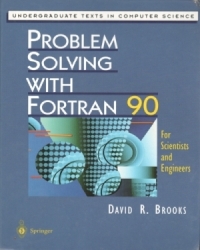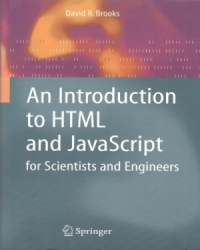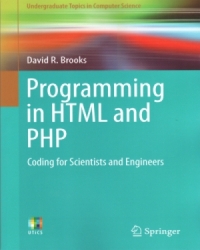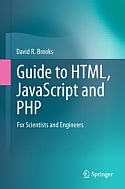All three of the abstracts listed here and below have been accepted for presentation at the December 2021 AGU meeting in New Orleans. They have been prepared as part of the NSF-funded ECoSTEM: Environmental Computing and Community Engagement in STEM Education project by Xavier University of Louisiana faculty and students, in collaboration with IESRE.
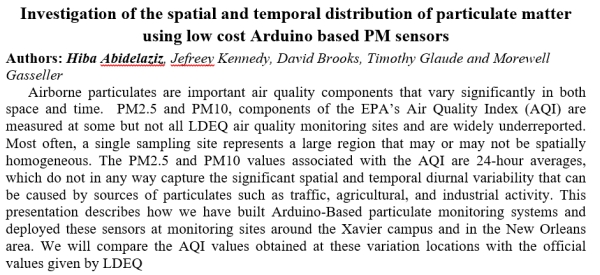
This is the second ECoSTEM presentation submitted to this year's AGU meeting in New Orleans (see October 8 posting). The first author on this submission is a Xavier undergraduate Research Assistant for ECoSTEM.
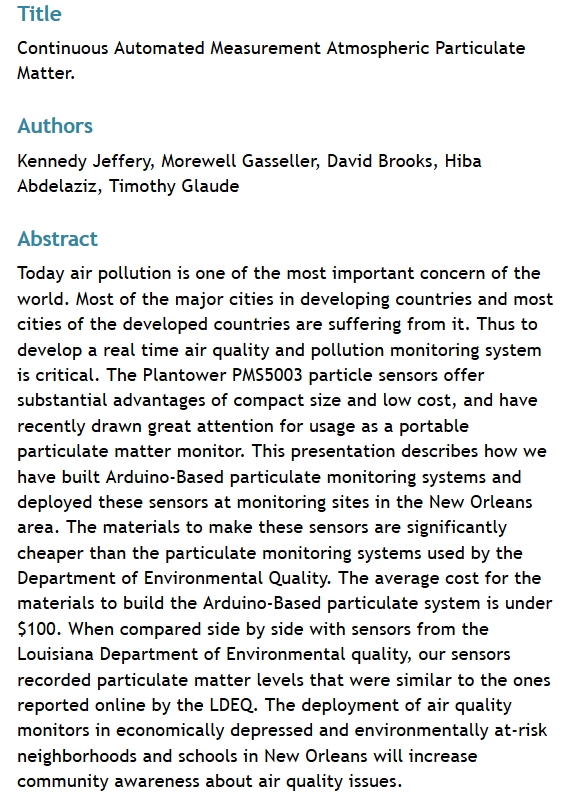
A poster presentation about The Environmental Computing and Community Engagement in STEM Education project (ECoSTEM) at Xavier University of Louisiana will be posted on the Earth and Space Science Open Archive (ESSOAr). This poster will also be included in the American Geophysical Union (AGU) meeting held in New Orleans in December. Morewell Gasseller is project PI, Timothy Glaude is Co-PI, and Kennedy Jeffery and Hiba Abdelaziz are Xavier student research assistants who had prominent roles in ECoSTEM's summer professional development workshop for middle and secondary school teachers at Xavier. IESRE provides project development, technical, and equipment support for the project's particulate monitoring activities.
Environmental Computing and Community Engagement in STEM Education:
Building Effective and Sustainable Relationships.
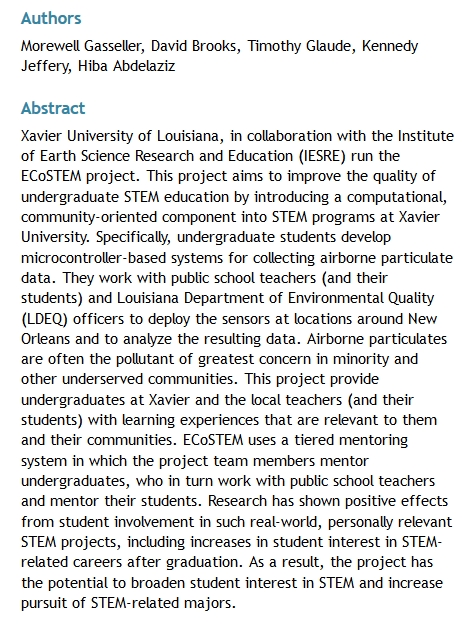
In response to what we believe are inappropriate changes to Pennsylvania's Science Education Standards, IESRE's Board of Directors has unanimously agreed to submit public comments opposing the proposed changes. A copy of the letter can be found HERE.
IESRE is a consultant for ECoSTEM, a three-year project directed by Xavier University of Louisiana, funded by the National Science Foundation through its Improving Undergraduate STEM Education (IUSE) program. In 2019 IESRE's David Brooks suggested applying to this program and including a serious science focus to serve as the "backbone" for the project. Brooks and Xavier chose monitoring airborne particulates based on the need for such measurements in minority and other underserved communities in New Orleans and Brooks' work with developing Arduino-based PM sensors. Through ECoSTEM, Xavier will expand enrollment in its STEM-related courses and involve faculty and students in working with community schools in New Orleans as a way to expand definitions of how STEM education can impact its students.
You can find more about ECoSTEM HERE.
| Two students from Sitting Bull College, Fort Yates, North Dakota, are working remotely this summer as interns sponsored by Dr. Margaret Pippin at NASA/Langley Research Center. It's a long way from Langley Research Center in southeastern Virginia, and IESRE in southeastern Pennsylania, to Fort Yates, but two students have successfully assembled their particulate monitoring instruments using online instructions prepared by IESRE President David Brooks when he built prototypes. In the left-hand image, one student is soldering leads to the temperature/humidity sensor. The right-hand image shows the completed instruments with sensors, an Arduino UNO microcontroller, and an UNO "shield" with a clock and SD card for storing data with a date/time stamp. The white object visible in this image is the temperature/humidity sensor and the blue object is the particulate sensor. A "breadboard" version of this device is described in detail in Chapter 15 of Brooks' new book Exploring Your Environment with Arduino Microcontrollers. You can find instructions for building the device shown in this image HERE; it requires only a little soldering. Parts for this instrument, including the case but without the cutouts, cost a little over $100. (The Plantower PMS5003 particulate sensor itself is about $40, available from several online sources.) For more information, contact David Brooks at brooksdr@instesre.org. | |
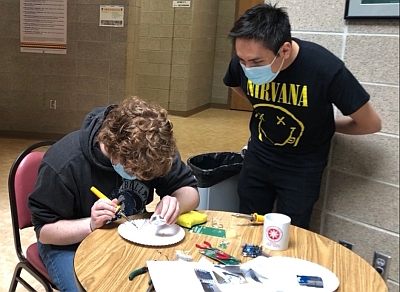 | 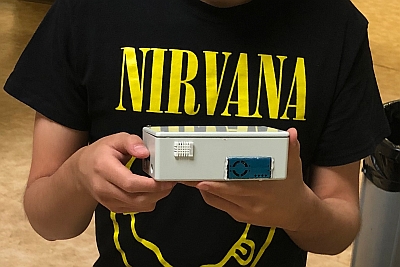 |
IESRE President David Brooks has self-published a book about using Arduino microcontrollers to explore the natural and manmade environment. This 150-page book is in 8-1/2" × 11" spiral-bound lay-flat format. It contains dozens of code examples, images of hardware layouts, and examples of data collected with sensors described in the text. The book is printed in black and white, but full color versions of many of the figures and graphs in the book are available online. Text for all the code examples in the book are also available for downloading by users of the book.
This book isn't an Arduino programming tutorial, but the many code examples will serve as a guide to using sensors and other devices to monitor, display, and record environmental data with this globally supported open-source microcontroller platform. It can serve as a supplemental text for teaching computer programming in a STEM context. It is suitable for students from upper middle school through college, and as a self-study guide for anyone wishing to take advantage of the many opportunities for environmental sensing with Arduinos. The book is available from IESRE at brooksdr@instesre.org for $25 including shipping to U.S. addresses. All proceeds go to supporting IESRE's work to develop more opportunities for understanding our environment.
 | 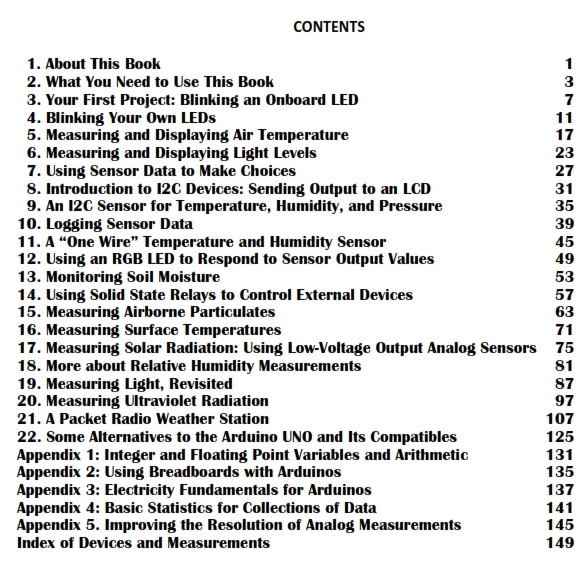 |
| The second annual "coding camp" for students already attending or about to start at Broughal
Middle School in Bethlehem, PA, was held during June-July, 2018. Student participants learned how to
program Arduino microcontrollers. Their projects included simulating traffic light patterns with LEDs,
building an
intrusion alarm using a small red laser as a transmitter and a cadmium sulfide photoresistor in a tube as
a detector, measuring soil moisture, and collecting temperature and relative humidity in the school's
greenhouse.
Equipment was provided by IESRE, starting last summer. Programming support was provided by IESRE's Dr. David Brooks. Course design was developed by Dr. Brooks and Dr. Jennifer Swann, Biology Professor, Lehigh University. Shown in the photo are, from the left, Dr. Brooks, Dr. Swann, Broughal MS teachers Drew Daubert and Christina Isernia, and Broughal MS librarian and Maker Space coordinator Dawn Bothwell. | 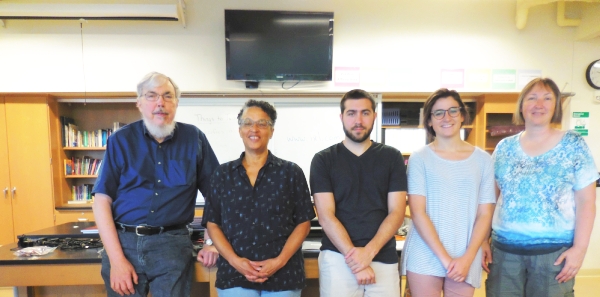
|
|
Can middle school students program Arduino microcontrollers using the Integrated Development Environment (rather
than some "drag and drop" visual environment?) Students made videos about the summer camp and here's a comment
from a rising 7th grader at Broughal Middle School: "[The code] may look like just a bunch of random words and stuff that you might not know, but once you, like, start coding more and more it gets very, very simple. Like for me, when I started out it was like what is this, I'm going to have a hard time in this. But actually as I kept going with the code it was very easy for me." |
 |
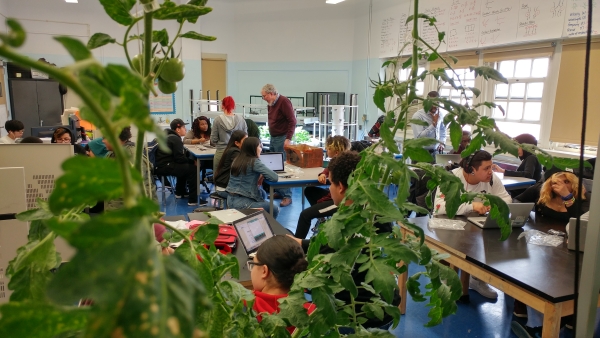
David Brooks and New York partner Paul Mondesire, have restarted a program at the Academy for Urban Planning and Engineering, Brooklyn, NY, that began last year. This photo is taken from behind one of the hydroponics setups in this classroom. Teacher Ashley Laino is standing to Dr. Brooks' left, near the back of the room. In this session, students are programming Arduinos to display readings from analog IC TMP35 temperature sensors.
|
David Brooks' new text, Programming in HTML and PHP: Coding for Scientists and Engineers, has just been published. This is Brooks' sixth book with the international scientific publisher Springer, starting with a Fortran 90 text published in 1997. |
|
| This photo shows an IESRE pyranometer installed in a research weather station in the mountains of Peru, in the Llanganuco Valley at an elevation of about 3900 m. (In the interests of protecting the security of the weather station, we do not know the exact location.) Note the mountain peak visible above the ridge in the photo. Our thanks to Robert Hellstrom, Geography Department, Bridgewater State University, Bridgewater, MA, for providing this image. | 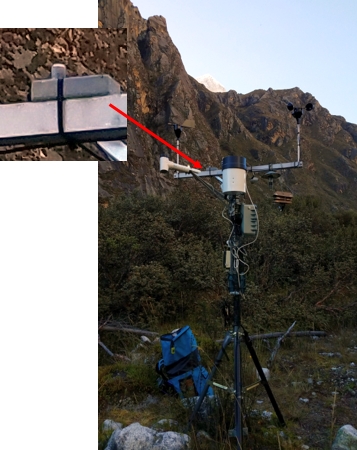 |
|
This past May, students at Delta High School, Delta, Colorado,
successfully launched their balloon project, which reached an altitude of 103,000 feet.
The payload included sensors to record temperature and pressure, a GoPro
video camera, and an IESRE pyranometer linked to an Arduino microcontroller with
a data logging shield. Here are videos of the
balloon flight and a
90-minute GoPro video
The balloon and its payload were successfully retrieved. Team Member Hannah Owens provides this description: "The balloon starts at about 8 feet in diameter and increases in size as it rises. For our project, it was about 30 feet in diameter when it burst at 103,000 feet. The payload has a parachute, but the fall is still intense on the payload. This year we secured the objects on the payload with a powerful foam so they would all stay in place. However, by the the time it has fallen the payload itself is in pretty bad shape and the only surviving items are the sensors, tracking, and recording equipment, which we make sure are very durable. We launched the balloon from very rural Delta, Colorado. The possibilities of where it could have landed range from a remote mountain top to the bottom of a canyon or gorge. The flight lasted about 90 minutes We got very lucky as it landed on public land about 30 miles east in Hotchkiss, Colordao. We tracked it with a Radiobug. Two of the people on the recovery team hiked for about an hour from the nearest road access point to the landing site and had to get the payload and balloon out of a tree." Congratulations to these students for a great project! |  |
 |
| Jerry Duggan, Microgrid Project Engineer, Colorado State University Energy Institute, Fort Collins, Colorado, has provided this photo of an IESRE pyranometer used in their project to determine how multiple pyranometers can be used to track cloud motion. 12 of these pyranometers will be deployed in a 200m x 200m square array, with a Kipp & Zonen pyranometer installed as a reference instrument in the middle of the array. Such a project is part of ongoing national efforts to determine how to integrate the highly variable input from solar photovoltaic arrays into the electric grid. IESRE's pyranometers provide an ideal low-cost solution for projects that require many pyranometers. | 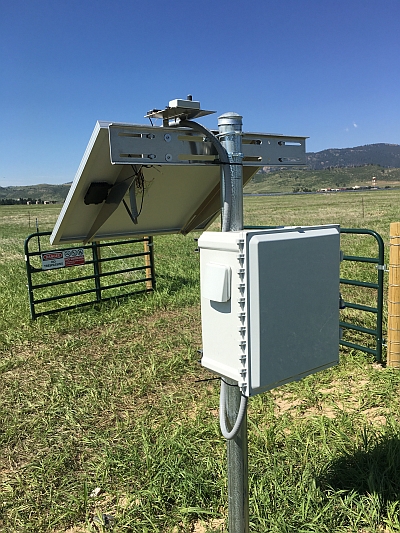 |
| David Brooks met at the Academy for Urban Planning with teachers from the AUP, the Green School, and the JVL Wildcat Academy in lower Manhattan, to plan student projects for environmental monitoring. The AUP has an active hydroponics gardening setup that provides a focus for these projects. Starting in the 2017-18 school year, IESRE will offer a series of onsite and online meetings with teachers and students to implement environmental monitoring projects using Arduino microcontrollers. |  |
| One of IESRE's goals is building opportunities for high-quality online teaching and learning experiences. When schools are able to take advantage of recent significant advances in online technology in their classrooms, collaborative online learning that helps to support teachers and students is becoming an integral component in high-quality science education. This image shows Brian Knoerzer and students from the Green School in Brooklyn, NY, discussing Arduino microcontroller coding for using photoresistors to measure and respond to light levels. Note the high quality of the image of Dr. Brooks being transmitted from his home office. Later, Dr. Brooks' webcam was focused on Arduino hardware asssembled for this session and screen sharing was used to demonstrate in real time the process of writing and testing Arduino code. Screen sharing by students as they write and debug their own code makes it easy to collaborate to create new projects and solve problems as they arise, in real time. This can save teachers and students possibly many frustrating hours of code debugging that can quickly be resolved by a "distant" mentor. | 
|
|
Mr. William Chen, an 11th grade student at Methacton High School, Worcester, Pennsylvania, has received a first place award in Earth and Space Sciences at the Delaware Valley Science Fair, the major student science fair competition in our area. His project looked at the quantitative relationship between sky color – in particular the gray scale brightness of clear sky images recorded at the same manual digital camera settings – to ozone, particulates, and water vapor in the atmosphere. It is widely observed that there is a qualitative relationship between sky color and atmospheric conditions, but it is not easy to transform these observations into a quantitative relationship. In addition to his first place award, Mr. Chen received special awards from the American Meteorological Society and NASA. He also received a $60,000 scholarship offer from Philadelphia's University of the Sciences. The support provided for this project by IESRE's David Brooks was made possible by a three-year grant awarded to IESRE by the Toyota USA Foundation in 2014. Their generous grant provides equipment and mentoring support for student environmental science research across the country. IESRE is pleased to have local students benefit from this support. |
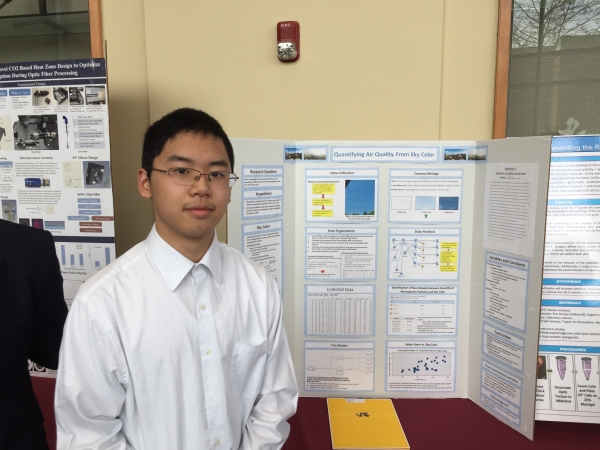 |
|
Dr. Brooks held a workshop for six teachers from three high schools in Brooklyn, NY:
The Academy of Urban Planning The Academy for Environmental Leadership The Green School: An Academy for Environmental Careers The purpose of the workshop, hosted by The Green School, was to develop environmental monitoring skills using a variety of sensors and Arduino microcontrollers. The workshop and related activities are supported by The Toyota USA Foundation, through IESRE's Facilitating Environmental Science Inquiry and Research for Students and Educators project. On the left is Paul Mondesire, who organized this activity with the encouragement and support of the Secondary School Superintendent for these schools and the office of the Brooklyn Borough President. All three of these schools serve predominantly minority populations and they understand the need to provide relevant educational opportunities for a wide range of students graduating into an increasingly technical world. We believe that familiarity with microcontrollers is as essential for today's 21st century students as basic computer literacy was for the late 20th century. |
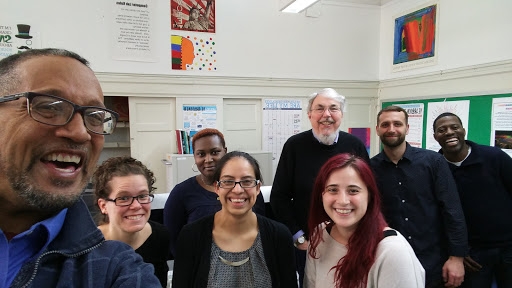 |
 | 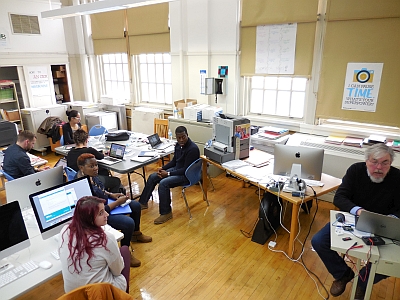 |
| Testing a soil moisture sensor | Writing Arduino code |
As noted in the posting below for August 27, 2016, IESRE calibrated sun photometer number 1000 earlier this year. In a milestone of a different kind, it was recently brought to our attention that a sun photometer originally built and calibrated in 2006 was being offered for sale on EBay. The online photos indicated that it is in, as they say, "like new" condition. Our guess is that it has been sitting unused on a school shelf somewhere. We hope the new owner takes advantage of this instrument, and we would enjoy hearing from them!
| Dr. Brooks met with State Senator John Rafferty (second from left), representatives from PennEnvironment, and two of Senator Rafferty's constituents to discuss climate change and clean energy policy initiatives for 2017. Brooks pointed out that economic forces are now as important as policy for promiting a clean energy future, and he urged Senator Rafferty, already a strong supporter of environmental issues, to support improvements in the Alternative Energy Portfolio Standards Act (Act 213), including increasing the "solar carve-out" provision as a way to create more job opportunites in the renewable energy market. |
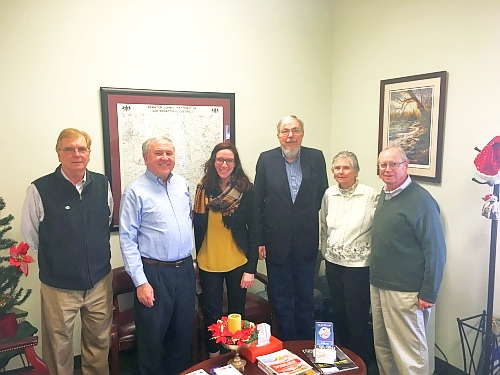 |
| A new student research project is underway at Orange Elementary School,
Waterloo, Iowa, supported by IESRE's
FESIRSE program, funded by the Toyota
USA Foundation. Working with Expanded Learner Program Teacher
Stacey Snyder, two students are studying the influence of weather on
bird behavior at the school's feeder. As can be seen from the photo, Orange Elementary
School is an ideal place for a weather station because of minimum interference from
trees, large building, and other possible intrusions on the horizon. The school is
also planning plantings around the school to provide a more bird-friendly environment.
IESRE partner Youth Learning As citizen Environmental Scientists (YLACES) (http://www.ylaces.org/) has funded purchase of an automated weather station for the school, which will be installed soon. |
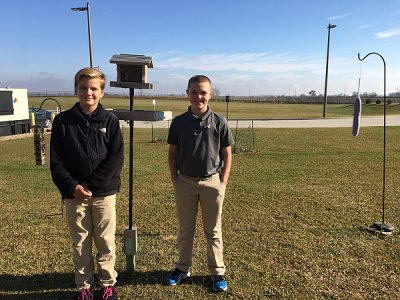 |
David Brooks gave a presentation at the MCSTA Mini-Convention about his online applications for accessing NOAA weather/climate data.
|
The two-channel LED-based sun photometer shown here, with serial number
RG8-1000, marks a milestone
for these instruments. LED-based sun photometers were developed for the GLOBE program by
David Brooks and Forrest Mims in the mid-1990s, starting with a one-channel instrument built
in an off-the-shelf RadioShack plastic case. By 2000, a two-channel version was developed
with spectral responses centered around 505 nm (green) and 625 nm (red) wavelengths. They
continue to be available through the Institute for Earth Science Research and Eduction,
Intially, these instruments required a separate plug-in voltmeter to read the outputs. By 2001, the current RG8 series of instruments, using a custom-designed pc board on which through-hole components are hand-soldered, had both a built-in digital panel meter and an IC temperature sensor to monitor air temperature inside the case. When an initial stock of custom-made cases ran out and was considered too expensive to replace, IESRE switched to modified stock ABS plastic cases, which is what is shown here. The 1000 serial number doesn't represent the total production history of these instruments. Along the way other versions of this instrument were also made, including more than 100 RG8-series instruments "branded" for NASA's CALIPSO program and physically similar instruments for measuring total colum water vapor in the atmosphere. The current pc board design allows the addition of two more detectors for custom applications. We believe these sun photometers are unique among inexpensive atmosphere monitoring instruments for student and other research. Since 2003, one or two RG8 series instruments, which also include a blue-channel detector, have been calibrated each year by Forrest Mims at Mauna Loa Observatory in Hawaii. The "Langley plot" calibrations done at this unique high-elevation laboratory are widely accepted as the gold standard for sun photometer calibrations and provide reference sources for "transfer calibrations" of all these sun photometers (except for a few dozen which have been purchased and calibrated by the Royal Netherlands Meteorological Instute (KNMI) in the Netherlands, in support of their student atmospheric research programs.) | 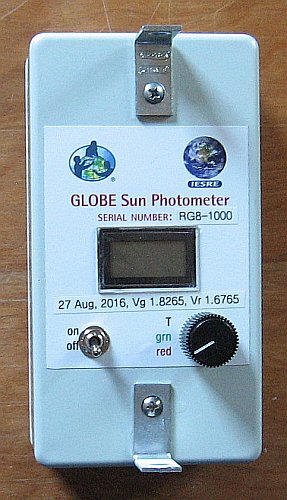 |
On June 4 and 5, David Brooks presented a workshop about using Arduino microcontrollers for environmental monitoring at Brooklyn College, in collaboration with Dr. Rebecca Boger, Associate Professor, Earth and Environmental Sciences. The workshop was a project of IESRE's Toyota USA Foundation-sponsored FESIRSE project. The workshop participants included undergraduates at Brooklyn College, a public school teacher, and two Brooklyn College professors who work with community groups and students. Each participant received Arduino Uno R3 microcontroller and data logging boards, plus additional components and tools used during the workshop.
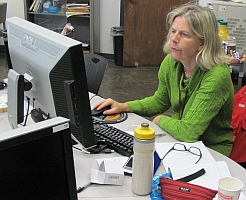 |  |
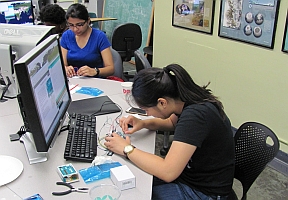 |
| As IESRE's Toyota USA Foundation-sponsored FESIRE project matures, we continue to develop our ability to deliver high-quality online content. This screen shot shows students from the JVL Wildcat Academy at the end of a 1-1/2-hour Skype session, during which we developed code for using Arduino microcontrollers and solid state relays to control 110-V lights and fans. STEM Teacher Anthony Brown is second from the left in the photo. | 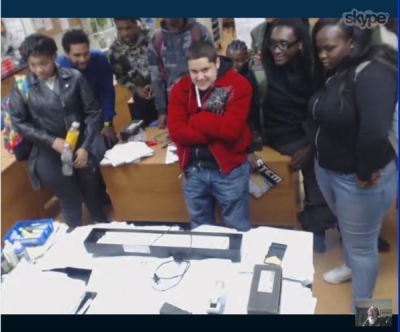 |
| Students working on the air-suspended particulate collection project started earlier this year by Lisa Chizek, grades 5-6 science teacher and STEM coordinator at North Tama Elementary School, Traer, Iowa, participated in North Tama's STEM Fair on April 8. The photo shows Dr. Ryan Wise, Iowa's Director of Education, discussing the project with students. The particulate collection device, designed for this project by David Brooks with support from the Toyota USA Foundation's grant to IESRE, Facilitating Environmental Science Inquiry and Research for Students and Educators project, is shown mounted on a camera tripod at the right of the photo. Also visible in the photo is the digital microscope, connected to a laptop, which students use to count particles collected on a microscope slide taken from the collector, which has a small battery-powered fan to blow air across the slide. | 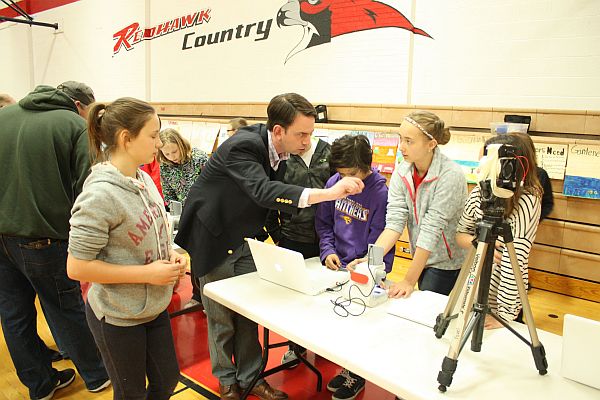 |
Jason Qiu and William Chen presented their particulate monitoring projects at the Montgomery County Science Fair, March 9-10, 2016. Mr. Qiu won Third Place in the Enviromental Science category. Mr. Chen won First Place in the Earth and Space Science category. Both students will be participating in the regional Delaware Valley Science Fair later this month. We extend our thanks to Mr. Robert Helm for his continuing support for student research at Methacton High School!
|
Following up on an inquiry from Lisa Chizek, a grades 5-6 teacher and the STEM coordinator
at North Tama Elementary School, Traer, Iowa,
David Brooks used support from the Toyota USA Foundation-sponsored FESIRSE project to design
some simple devices for collecting particulates in the air, shown here. The collector consists of a PVC pipe coupling, a small
fan, and a slot holding a microscope slide. The images below show students setting up their collectors
on camera tripods, with
2 D-cells to power the fan.
Tama County is a rural farming county located in central Iowa. The North Tama School District population is predominantly Caucasian, with only about 7% of students belonging to any race "other than White." About 35% of students are eligible to participate in free or reduced-price lunch programs and about 13% are from families meeting U.S. Census Bureau definitions for living in poverty. In 2015 North Tama Elementary School received the Iowa STEM Redesigned Learning Environment Grant from the Iowa Governor's STEM Advisory Council. The grant application was co-written by Ms. Chizek. |
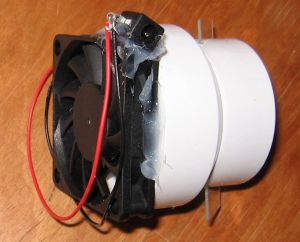 |
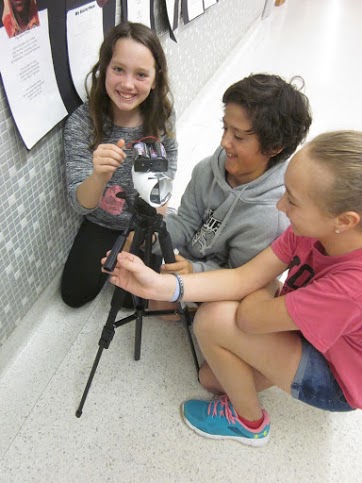 | 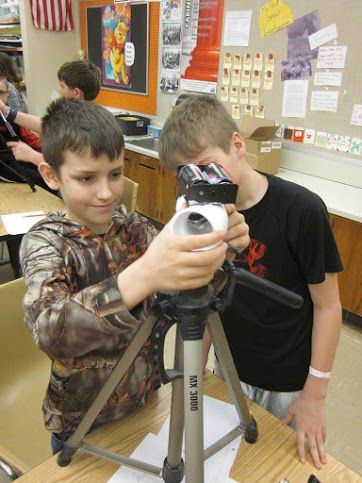 |
David Brooks traveled to JVL Wildcat Academy Charter School lower Manhattan for the first of two pyranometer-building workshops at this school in 2016, almost exactly one year after the first such workshop was held in February 2015. Building instruments is a cornerstone of IESRE's approach to hands-on student-centered environmental science education. More than half the dozen students in this STEM class are young women. STEM teacher Anthony Brown is shown at the right. This project is supported by a three-year grant from the Toyota USA Foundation for for IESRE's Facilitating Environmental Science Inquiry and Research for Students and Educators (FESIRSE).
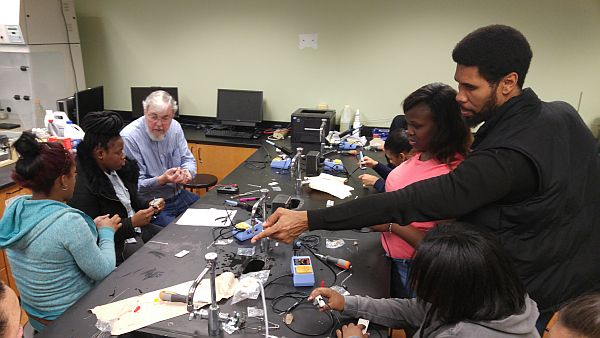 |
Jason Qiu and William Chen, 9th and 10th grade students at Methacton High Schoool, Worcester, Pennsylvania, presented their projects at the 2016 PJAS Region 1B Science Fair on February 20. This region is one of the most competitive in the entire state, with several hundred students participating from 22 private and public schools. Both students' projects examined the properties of inexpensive sensors for counting particulates in the atmosphere. These inexpensive devices (~$15-25), which can be interfaced with Arduino microcontrollers, use scattered light from near-IR LEDs to detect passage of particulates through a small chamber. Mr. Qiu studied the dependence of sensor outputs on air temperature and humidity. Mr. Chen developed models relating the output of these sensors to outputs from a $300 Dylos DC1100 laser-based particle counter.
Through its Facilitating Environmental Science Inquiry and Research for Students and Educators (FESIRSE) project, sponsored by the Toyota USA Foundation, IESRE provided science and technical mentoring, Arduino boards and datalogging shields, a design for a fan-aspirated sensor setup, and the loan of a Dylos particle counter. This level of support makes it possible for students who do not have access to professional laboratory facilities (often through family members or other relatives) or who are interested in areas of science not likely to be supported in such facilities, to compete with high-level environmental science projects that would otherwise not be possible.
The righthand photo shows David Brooks, William Chen, Jason Qiu, and Robert Helm, Co Director of the Pennsylvania Junior Academy of Science Region 1B and science fair advisor at Methacton High School
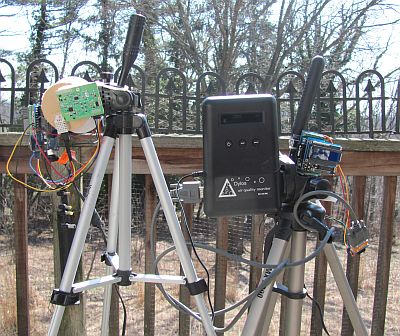 | 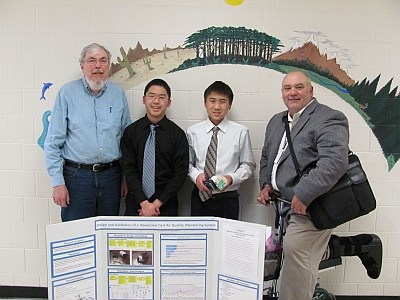 |
The lefthand photo shows an Amphenol/Telaire particle counter mounted on a PVC elbow. A small fan, which pushes air through the sensor is mounted at the other end of the elbow. The small white rectangle at the lower left of the Telaire sensor pc board, is a temperature and relative humidity sensor. This entire IESRE-designed assembly, including the Arduino microprocessor with a datalogging shield, can be replicated for less than $75. The instrument at the right is the Dylos particle counter, with its serial port output connected to an Arduino which reads data from the Dylos, displays it on a small LCD screen, and logs the data.
IESRE is working on an online document describing the opportunities and challenges offered by these devices. The work of both students will be included in this document. Both students will be attending the Pennsylvania State Science Fair later this year. Both students received a cash award from Merck, the pharmaceutical giant which has a large local presence, for the perfect presentation scores awarded by PJAS judges.
| IESRE has started its fall 2015 FESIRSE project with the STEM program at John V. Lindsay Wildcat Academy Charter School.
During the summer we worked closely with teacher Anthony Brown to focus the STEM curriculum
around environmental themes. The rare opportunity for extended STEM
classes at JVL, along with a consistently high level of administrative support, continues to inspire this project.
This year, we have started the fall program with an introduction to Arduino microcontrollers. Later in the semester we will once again
build pyranometers, a "signature" activity for IESRE programs when we work with students and teachers.
It is worth noting that Mr. Brown was inducted this year as a Fellow in the New York Academy for Teachers and was one of 18 New York teachers to be selected to participate in a chemistry Master Class with Nobel Laureate Roald Hoffmann. Also this year, JVL Wildcat Academy was awarded a Bronze rating in the 2015 US News & World Report annual rankings of New York high schools. JVL Academy is an "alternative" high school for students who have had problems at traditional high schools. The student body is 99% minority and more than three-quarters from economically disadvantaged backgrounds. Considering these demographics, these are remarkable achievements and IESRE is proud to be partnering with this institution! | 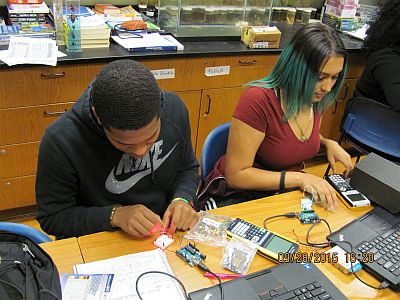 |
| At the Eastern Iowa Science and Engineering Fair, held March 21, 2015, two students from Evans Middle School, Ottumwa, Iowa, presented
their project on testing phosphate and nitrate levels in the Des Moines River. Their project won 1st place
in their competing division (Geology/Water Science Research). They were in the top 15 out of over 100 junior exhibits and
they received an outstanding mention for the statistical analysis of their results.
IESRE is pleased to have supported this project through our USA Toyota Foundation-supported project, Facilitating Environmental Science Inquiry and Research for Students and Educators. We provided water testing kits and ongoing support for the students during the course of their research. This successful project has provided valuable lessons on providing equipment and personal support "at a distance" – an essential component of sustainable programs to improve the infrastructure for supporting authentic student science research. |
 |
The Facilitating Environmental Science Inquiry and Research by Students and Educators project (FESIRSE) is supported by a generous three-year grant from the Toyota USA Foundation.

| Students at l'Ecole des Mines d'Alès, Alès, France, have installed a web-connected weather station, including two IESRE pyranometers. This school, founded in 1843, offers diplomas in civil engineering, materials and mechanics, risk and environmental management, and system and production engineering. Under the guidance of Mr. Frédéic BOEF, students in the civil engineering program are engaged in a project to build low-cost monitoring systems. The system shown here uses open-source Raspberry Pi and Arduino technologies to collect data and post it online. The radiation shield, which contains relative humidity and temperature sensors, is constructed from flowerpot saucers. | 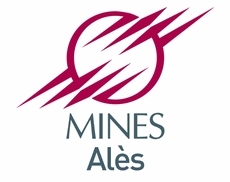 |
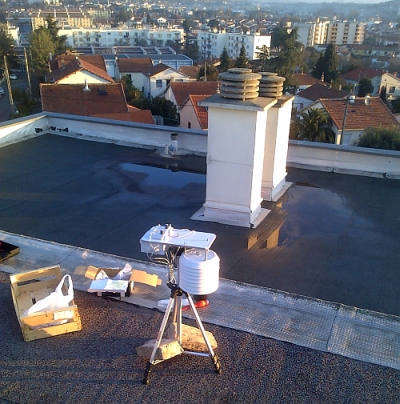 |
 IESRE is pleased to announce that it has received one
of 23 grants awarded
nationwide by the Toyota USA Foundation to organizations
supporting STEM and environmental education.
IESRE is pleased to announce that it has received one
of 23 grants awarded
nationwide by the Toyota USA Foundation to organizations
supporting STEM and environmental education.
In its formal announcement, Michael Rouse, Toyota USA Foundation President, says: "At Toyota, we believe that when we provide young people with exciting opportunities in STEM we can help cultivate the next generation of engineers, scientists and technologists – and that benefits all of us. This year's grant recipients are among the most innovative education programs in the country. We are inspired by their work and look forward to seeing what their students will accomplish, both this school year and beyond."
The Toyota-supported project, Facilitating Environmental Science Inquiry and Research for Students and Educators (FESIRSE) will allow IESRE to continue and expand its programs supporting authentic student research through professional development for teachers and support for students by providing research ideas, science support and mentoring, and research equipment. Click HERE to learn more about FESIRSE.
The Toyota USA Foundation has a charitable endowment of approximately $100 million and supports STEM education programs serving kindergarten through 12th grade students. In 2014, the Foundation awarded over $5 million in grants. Over the past 20 years, Toyota and the Toyota USA Foundation have contributed nearly $700 million to nonprofits across the United States. Click HERE for more information about the Toyota USA Foundation.
Water vapor is a major atmospheric component in our understanding of weather and climate, but there is not enough information available about local variability in total column water vapor for high-quality modeling of this quantity. In 2011, IESRE's David Brooks was co-author on a paper:
Mims, Chambers, and Brooks: Measuring total column by pointing an infrared thermometer at the sky. Bull. Am. Met. Soc., 92, 1311-1320, 2011
The inexpensive protocol, using commercially available handheld IR thermometers costing about $50, is the topic of a recently published NASA Technical Memorandum: Merceret and Huddleston: Assessment of a Technique for Estimating Total Column Water Vapor Using Measurements of the Infrared Sky Temperature, NASA/TM-2014-218368
This paper provides a very thorough and favorable assessment of the technique developed by Mims. These measurements can easily be made by students and can be the basis of authentic research projects – the Merceret and Huddleston paper includes some suggestions. Handheld IR thermometers are inexpensive and they have many other interesting classroom applications. But in any case, In return for a student research plan, handheld IR thermometers are available on loan from IESRE, for the duration of a research project (through IESRE's NASA-funded CSRES project).
| David Brooks (far left in photo) participated in the "Building the Climate Change Education and Communication Collective" workshop and symposium at the National Council for Science and Education's 14th National Conference, "Building Climate Solutions," held in Arlington, VA, January 27-29. Brooks and two other PI's for the NASA Innovations in Climate Education (NICE) program discussed their projects and participated in planning for building a "backbone" organization to support climate science education. |  |
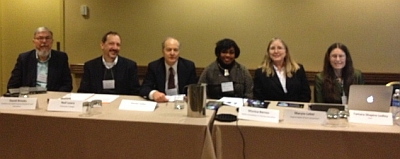 |
| David Brooks presented a poster describing new online applications for accessing and visualizing NOAA climate data at the meeting for PIs of climate science education projects funded by NASA, NOAA, and the NSF, held in Arlington, VA. These data – 30-year climate normals, the US Historical Climatology Network, and the US Climate Reference Network – provide the primary sources that students need for authentic climate research. The applications are available HERE. |
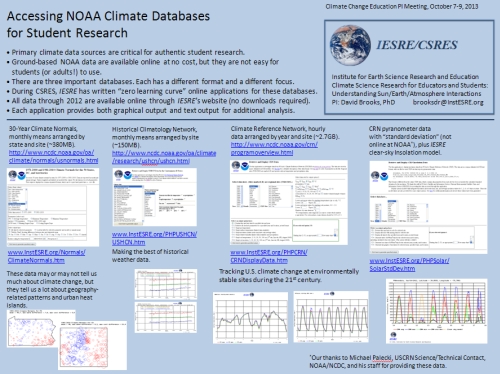
|
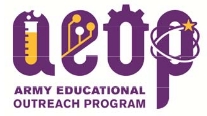
This summer, 40 IESRE pyranometer kits were used by high school students at a summer science, technology,
engineering, and mathematics program at the U.S. Army's Aberdeen Proving Ground, Maryland,
sponsored by the Army Educational Outreach Program.
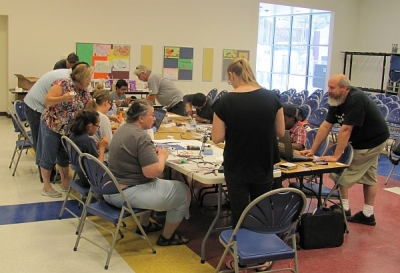 | 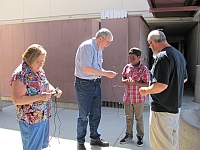 |  |
IESRE's David Brooks and Robyn Dahl from UC Riverside held a three-day workshop for students and teachers from
Riverside STEM Academy and other middle schools in the Riverside (California) Unified School District. Participants built pyranometers,
discussed climate science issues related to Earth's radiative balance, and started writing plans for student research projects
starting in the fall. The workshop also introduced new online software, written
by Brooks, for examining 30-year climate means and data from NOAA's Climate Reference Network – a data set that will form
the basis for tracking climate changes in the continental United States during the 21st century.
An online application for accessing and displaying data through the end of 2012 from any of the more than 200 sites in NOAA's Climate Reference Network (USCRN) is now available. The first site, in Asheville, NC, start reporting data in 2000. Parameters (not all parameters are available at all sites) include air, surface, and soil temperature, soil moisture, precipitation, relative humidity, and insolation. These applications are available for anyone to use. The first application, for accessing the CRN data in the hourly average files, can be found HERE. The second application provides text and graphical output for a special set of insolation data provided to IESRE; it includes a standard deviation calculation in addition to the values available in the hourly data files; sample data from Avondale, PA, are shown here. The orange line is the clear-sky model and the black line is the standard deviation (as calculated, a measure of data range rather than "standard deviation" in the usual statistical sense). This application is available HERE.
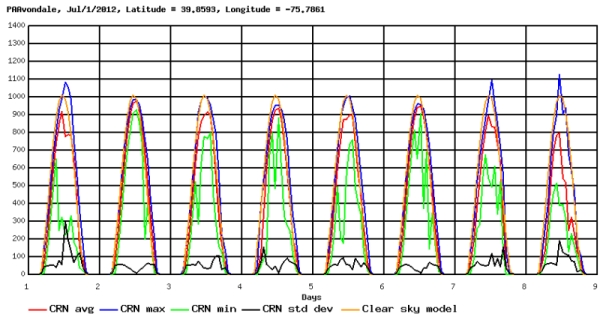
|
Students from Dr. Suzanne Banas' science classes at South Miami Community Middle School have submitted three manuscripts to the special climate science edition of Journal of Emerging Investigators, to be published in the summer of 2013. (See the notice for this student publishing opportunity on our home page.) This photo and text was included in the current newsletter from Dr. Banas' school district. Our congratulations to Dr. Banas and her students for the work they have put into these CSRES-sponsored projects! | 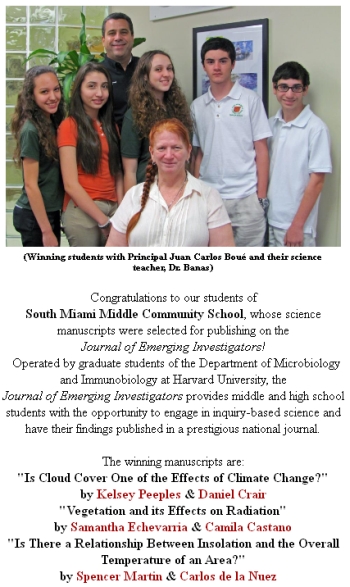 |
| IESRE President David Brooks attended the June 10-14, 2012 GLOBE/Europe-Eurasia Annual Conference in De Bilt (a few
kilometers from Utrecht), Netherlands.
This meeting included an entire day devoted to aerosols and student measurements using the two-channel LED-based
sun photometer developed for the GLOBE program in the 1990's by Brooks and Forrest Mims. In 2003, the Netherlands' Royal Meteorological Institute (KNMI) and the GLOBE Program in the Netherlands
started a collaborative program of collecting aerosol optical thickness data that has continued to the
present time and is now being expanded to other European and Eurasian countries.
The aerosols monitoring program in the Netherlands is one of the most successful student/teacher/scientist research collaborations in the world. Student sun photometer data from Dutch schools have been used in peer-reviewed publications and continue to provide ground validation support for space-based instruments measuring aerosol optical thickness. Since the beginning of its support for the GLOBE Program, KNMI has recognized that the goal of obtaining reliable and usable results from student measurements can be achieved only with ongoing high levels of scientific support. This support is continuing under the leadership of KNMI scientist Elise Hendriks, who organized the session at KNMI's headquarers. In addition to sun photometry, Brooks also discussed the use of inexpensive IESRE-designed pyranometers for monitoring solar radiation at Earth's surface, a new IESRE-developed sensor to monitor surface radiating temperature, and a cellphone application for interpreting black carbon deposited on filters, developed by Nithya Ramanathan, founder of Nexleaf Analytics. |
 |
 | 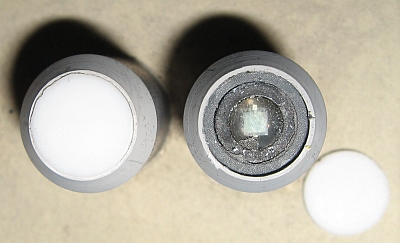 |
|
One of the first prototypes of the inexpensive IESRE pyranometer
has finally failed. Although it may seem strange to announce the failure of an instrument, we believe the long life of this
device is worth celebrating! One-minute insolation samples have been collected from this instrument continuously since May 2008.
An initial calibration
against a new Apogee pyranometer in 2008 was followed last year with a calibration against a new Kipp & Zonen SP-Lite pyranometer. The
graph at the right shows the first data collected with the co-located Apogee instrument during very cloudy weather in May 2008. (The graph was only for our internal use, so we didn't bother
to label the axes.) The difference
between the 2008 and 2011 calibration constants, which could have been caused by a combination of changes in the IESRE pyranometer and performance
differences between the Apogee and Kipp & Zonen instruments, was less than 1%! The source of the failure of this instrument, which caused the output to drop by nearly half over a few weeks, is unknown. The photos show that the case and the housings are dirty and faded, but the Teflon diffusers look brand new — unaffected by years of constant exposure to sunlight. Under the diffuser, the surface looks like a small amount of superglue may have seeped in around the photodiode when it was installed, but there is no serious degradation of this surface. (The lefthand housing is for an uncalibrated near-IR detector.) Regardless of the source of the problem with this instrument, we believe this is a remarkable performance record. There is no point in trying to recalibrate such an instrument when the source of the dramatic change in output is unknown. The low cost means not only that multiple observing sites can be established very economically, but also that when an instrument eventually fails (as all instruments will), the most reasonable course of action is simply to replace it! | 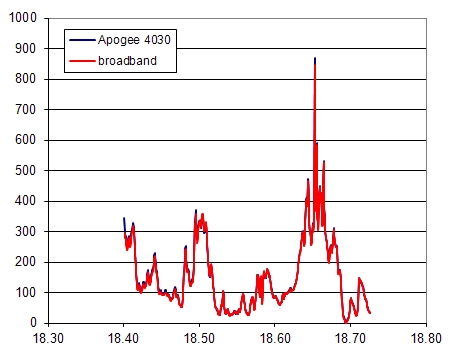 |
| David Brooks gave an invited presentation entitled "Climate Research by K-12 Students: Can They Do It? Will Anybody Care?" at the fall meeting of the American Geophysical Union in San Francisco. You can find a PDF version of the PowerPoint presentation here. | 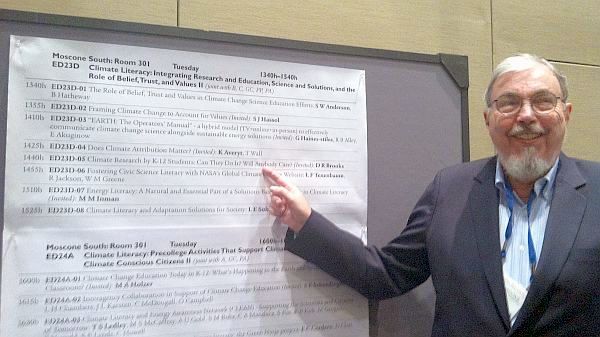 |
A brief description of IESRE's Climate Science Research for Educators and Students (CSRES) project appears in the December 2011 edition of the NASA Earth and Space Science Education E-Newsletter. To subscribe to this newsletter, e-mail "ese_ed_newslist-subscribe@lists.hq.nasa.gov" with "subscribe" (without the quotes) as the subject.
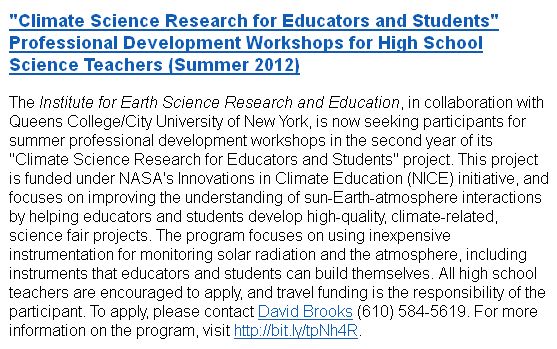
A Meeting Report by David Brooks entitled Engaging Students in Authentic Climate Research: Raising the Bar for Climate Science Education has appeared in the American Geophysical Union's weekly member newletter: EOS Volume 92, Number 44, , p. 388, 1 November 2011. The report summarizes results from the student climate research workshop sponsored by NOAA and NSF in November 2010. For more details about this workshop, visit the project website.
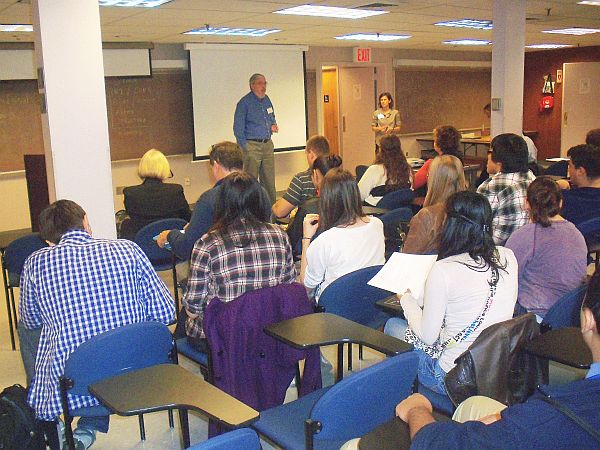 November 10, 2011: IESRE CSRES project participants meet with GISS scientists
November 10, 2011: IESRE CSRES project participants meet with GISS scientistsOn November 8, approximately 60 students and teachers from New York City and some suburban communities, plus a few parents, met with 11 scientists at NASA's Goddard Institute for Space Studies in Manhattan to discuss their climate-related science projects. The meeting was part of IESRE's Climate Science Research for Educators and Students (CSRES) project, in collaboration with Queens College/City University of New York. Many of the students are preparing climate-related projects for science fairs in the NYC area and this meeting gave them a chance to get feedback on their project plans from GISS climate scientists. In the photo, Project Director David Brooks and GISS scientist Ann Fridlind are explaining the day's activities. For more information about CSRES, visit this website
| Near the end of July, IESRE reached a milestone with its 100th calibrated pyranometer. In keeping with IESRE's education and research mission, these instruments are being used by professional researchers, teachers, students for science projects, colleges and universities, individuals interested in solar power, and our own projects including the NASA-funded Global Climate Change Education project in collaboration with Queens College, City University of New York. Hundreds more pyranometers have been provided in kit form to a wide audience. Building these kits is always part of our educator professional development workshops, for example; this is an activity that actively combines science, technology, engineering, and mathematics — the four components of STEM education. | 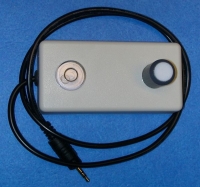 |
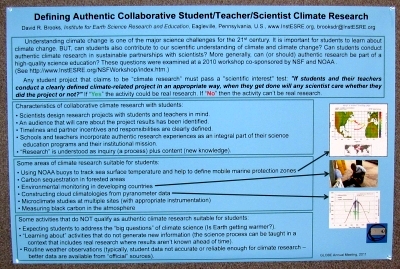 July 20, 2011: David Brooks at the 15th GLOBE Annual Meeting
July 20, 2011: David Brooks at the 15th GLOBE Annual MeetingThe 15th GLOBE Annual Meeting, held in Bethesda, Maryland, marks a significant new chapter in the history of this program, With a new Director, we hope this once-unique program will be able to re-commit itself to supporting authentic student research as an integral part of its mission. To date, there has been little evidence that the GLOBE "Student Climate Research Campaign" (SCRC) will, in fact, encompass activities that can realistically be called student "research" — based on the assumption that words really do matter, the available evidence suggests that it might be more accurately described as a student "inquiry" or "investigation" campaign. Based on the 2010 workshop on defining authentic student climate research (see November 17-19 item below), IESRE prepared a poster presentation for this meeting. More importantly, however, are the conversations, both informal and as part of discussion groups, about the future of student research within the GLOBE Program and, in particular, the future of the SCRC. Our message, of course, is that in addition to learning about Earth's climate and how it is changing, students and their teachers can and should participate in authentic climate-related research in collaboration with scientists.
(See April listing below.) A new paper, Measuring Total Column Water Vapor by Pointing an Infrared Thermometer at the Sky, By Forrest Mims, Lin Chambers, and David Brooks, is available in an "Early Online Release" PDF format here:
http://journals.ametsoc.org/doi/abs/10.1175/2011BAMS3215.1
This is the complete article, as accepted by BAMS, but not yet journal-formatted. It is unclear how long this paper will be available online in this format, so anyone interested should download and save this version. (Click on the PDF link.)
| David Brooks' new HTML, JavaScript, and PHP programming book is now available. The link to Springer's website is here |
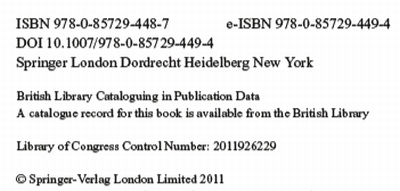
|
| Our friend and colleague Forrest Mims is once again at Mauna Loa Observatory in Hawaii to do his annual calibrations of atmospheric monitoring instruments, including two IESRE pyranometers and our two reference LED-based sun photometers. The photo at the far right shows the pyranometers installed at MLO. In the background are several research-quality radiometers and Mauna Kea is visible behind them. Note the band of clouds in the image. These clouds are below the observatory, which is at an elevation of 3397 m. The other photo shows clouds, including cirrus, over the Observatory at twilight, June 14, 2011. Cirrus clouds during the day interfere with sun photometer calibrations. (Both photos used with permission from Forrest Mims.) | 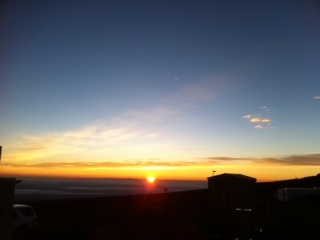 |
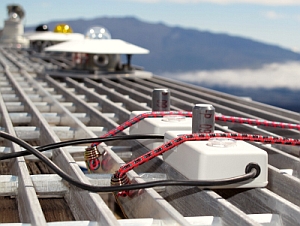 |
| The sun photometer calibrations are based on so-called Langley plots. These calibrations require a stable atmosphere and MLO is the site preferred for such work by atmospheric scientists. Manually collecting the data takes several hours, starting just after sunrise and continuing as the solar elevation angle increases during the morning. Under a stable atmosphere, a graph of the logarithm of the voltage output from the sun photometer as a function of the relative air mass should be a straight line. Although the weather over Hawaii has been unusually cloudy this year, clouds often lie below the elevation of the observatory and Forrest was able to obtain excellent data for our three-channel reference sun photometers on the morning of June 11; the results for one of the instruments is shown here. The two reference instruments are used as calibration sources for all of the sun photometers sold by IESRE. Comparisons with data from previous years continues to confirm that despite their low cost compared to commercial sun photometers, IESRE's LED-based sun photometers are extremely stable and reliable instruments for measuring aerosol optical thickness. | 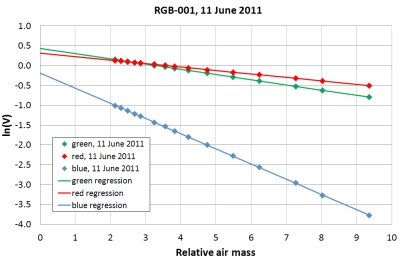 |
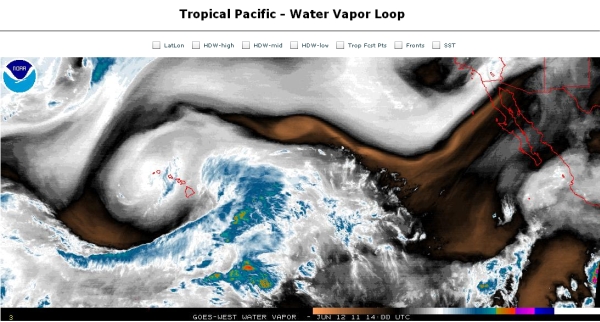 |
 David Brooks has just approved the final proof for his new book, Guide to HTML,
JavaScript and PHP For Scientists and Engineers, published by Springer as part of their Computer Series,
ISBN 978-0-85729-448-7. This book combines two previous Springer books by Brooks, An Introduction to HTML and JavaScript
for Scientists and Engineers, and An Introduction to PHP for Scientists and Engineers, with new
material, including a chapter devoted to using graphics with PHP. The PHP chapters of the book focus on
using PHP to read and write external data files stored on local or remote servers -- an essential task for
engineering and scientific applications. Like the previous books, this new book
includes many complete code examples that serve as models for solving typical programming and computational
problems. There is an extensive set of exercises. The book will be available by late summer, 2011. Both
paper and electronic versions will be produced.
David Brooks has just approved the final proof for his new book, Guide to HTML,
JavaScript and PHP For Scientists and Engineers, published by Springer as part of their Computer Series,
ISBN 978-0-85729-448-7. This book combines two previous Springer books by Brooks, An Introduction to HTML and JavaScript
for Scientists and Engineers, and An Introduction to PHP for Scientists and Engineers, with new
material, including a chapter devoted to using graphics with PHP. The PHP chapters of the book focus on
using PHP to read and write external data files stored on local or remote servers -- an essential task for
engineering and scientific applications. Like the previous books, this new book
includes many complete code examples that serve as models for solving typical programming and computational
problems. There is an extensive set of exercises. The book will be available by late summer, 2011. Both
paper and electronic versions will be produced.David Brooks recently joined Forrest Mims, Geronimo Creek Observatory, Seguin, Texas, and Lin Chambers, NASA Langley Research Center, as third author on a paper accepted by the American Meteorological Society's Bulletin of the AMS, dealing with using inexpensive non-contact IR thermometers to estimate total column water vapor in the atmosphere. This novel application of a widely available and inexpensive (<$50) handheld instrument was developed by Mims.
Especially because of the importance of this idea as an educational tool, the paper is careful to make the distinction between an actual "temperature," which is what is measured by these instruments when they are pointed at a nearby surface, and what they "see" when they are pointed up at a cloud-free sky. In the latter case, their detectors behave as radiometers that respond to IR radiation within their wavelength response.
Different models of non-contact IR thermometers give very different "temperatures" when pointed simultaneously at the sky (although they may be in close agreement when pointed up at the base of low clouds). However, it turns out that clear sky values for a particular instrument can be related to the total column water vapor in the atmosphere if an independently calibrated source of this value is available. Possibilities include near-IR sun photometers such as are available in NASA's AERONET system and NOAA's GPS-MET system, which uses signals from global positioning satellites to infer total column water vapor. The IR thermometer method has an advantage over sun photometry in that it can be used day or night whenever the sky within the field of view of the instrument is clear.
Based on a proposal submitted to the National Science Foundation (NSF) in 2009 and subsequently co-funded by NSF and the National Oceanic and Atmospheric Administration (NOAA), David Brooks led a 2-1/2 day workshop to define what it means for students and teachers to do authentic climate research in collaboration with scientists. The workshop was held at NOAA facilities in Silver Spring Maryland. 25 scientists and educators from across the U.S. and the Netherlands met to formulate a practical definition of authentic student research and to discuss specific projects that have high educational and scientific value. The workshop concluded that "student research" can and should be distinguished from inquiry-based and other student learning activities by producing real research results that are of interest to scientists and others.
The Institute for Earth Science Research and Education's proposal, "Climate Science Research for Educators and Students (CSRES): Understanding Sun/Earth/Atmosphere Interactions," submitted earlier this year in response to NASA's Global Climate Change Education (GCCE) initiative, has been accepted. There were 130 proposals submitted in response to this year's solicitation, and 17 will be funded.
This three-year project, directed by David Brooks, will begin in the spring of 2011. Major collaborators include Queens College of the City University of New York and NASA's Aerospace Education Services Project (AESP). CSRES takes as its science and education focus Earth's radiative balance, a topic that is poorly understood but is fundamental to understanding Earth's climate. CSRES will develop a set of inexpensive monitoring instruments and experiment protocols that allow educators and their students to conduct investigations that will provide the "data ownership" required to understand this complex topic. These measurements include solar energy reaching Earth's surface, surface reflectivity, aerosol optical thickness, and surface thermal emissions. These measurements will be supplemented by NASA products such as global top-of-the-atmosphere radiative balance data available through the NASA Earth Observations (NEO) website and aerosol optical depth, water vapor, and insolation data from ground-based AERONET sites.
CSRES will present its program through a series of professional development workshops for New York City teachers held at Queens College. This target audience is important because of the diversity of NYC's student and teacher population and because NYC schools have made a commitment to increasing their students' competitiveness in high-level national student science competitions. The project will start building the infrastructure required to encourage today's students to develop their own climate-related research projects (now conspicuously absent from high-level science competitions) and to choose climate related careers.
CSRES' partnership with AESP, NASA's longest running education outreach program, ensures that this project will reach a national audience of students and educators, including a pilot program in Iowa.
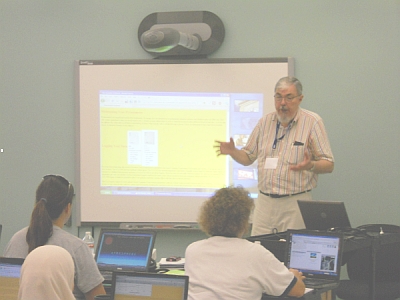 June 2010: IESRE participates in New Orleans Professional Development Workshop
June 2010: IESRE participates in New Orleans Professional Development WorkshopThe Institute for Earth Science Research and Education has been awarded a a subcontract, through Science Systems and Applications, Lanham, Maryland, to participate in the "Clouds, Dust, and Sunshine: Enhancing Our Understanding of Weather and Climate" workshop sponsored by NASA's Langley Research Center and organized by Hampton University, held in New Orleans, Louisiana, June 7-9, 2010. David Brooks provided IESRE-designed pyranometers and GLOBE sun photometers, background science information, and hands-on training in the use of these instruments to help students understand how sun/Earth/atmosphere interactions are responsible for Earth's weather and climate. New Orleans is also the site for a major NASA "A-Train" Earth satellite symposium to be held in October. Dr. Brooks will attend this symposium, at which workshop participants and their students have been invited to discuss projects with scientists attending the symposium. More information about the New Orleans workshop can be found here and on David Brooks' website.
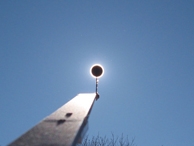 Following the historic snowstorms in the northeast during February, The Citizen Scientist, the online journal of the
Society for Amateur Scientists, published
snow photos and a solar aureole photograph from Brooks' home northwest
of Philadelphia, Pennsylvania.
Following the historic snowstorms in the northeast during February, The Citizen Scientist, the online journal of the
Society for Amateur Scientists, published
snow photos and a solar aureole photograph from Brooks' home northwest
of Philadelphia, Pennsylvania. 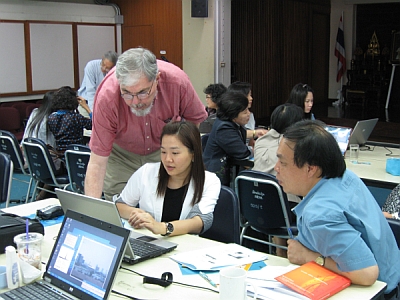 Brooks has traveled again to Thailand to continue his work with the Institute for the Promotion
of Teaching Science and Technology in Bangkok. Work is continuing on the development of pyranometers and inexpensive
data loggers for use in Thailand's schools. (See entry for January 2009.) Brooks gave workshops for teachers and IPST
staff in Bangkok -- the photo shows workshop participants analyzing sky photos of Bangkok taken from the roof at IPST.
He also gave a presentation about student climate research and the "KWL" approach to inquiry-based science learning.
(What do we know? What do we want to know? What have we learned?)
Brooks has traveled again to Thailand to continue his work with the Institute for the Promotion
of Teaching Science and Technology in Bangkok. Work is continuing on the development of pyranometers and inexpensive
data loggers for use in Thailand's schools. (See entry for January 2009.) Brooks gave workshops for teachers and IPST
staff in Bangkok -- the photo shows workshop participants analyzing sky photos of Bangkok taken from the roof at IPST.
He also gave a presentation about student climate research and the "KWL" approach to inquiry-based science learning.
(What do we know? What do we want to know? What have we learned?)| Year | P-007 Calibration factor (W/m2)/mV |
Departure from 3-yr avg. |
|---|---|---|
| 2007 | 5.6653 | -0.062% |
| 2008 | 5.6465 | +0.270% |
| 2009 | 5.6735 | -0.207% |
| 3-yr avg. | 5.6618 |
IESRE pyranometer P-007 was also included in the 2007 and 2008 BORCAL projects. The table shows an "average" calibration factor, for a solar zenith angle of 45°, for all three years.
NREL reports give detailed information about the responsivity of radiometers as a function of solar zenith angle. These data can be used in some situations to improve the accuracy of radiometers by substituting a zenith-angle-dependent calibration for the constant calibration. As a practical matter, such a substitution is rarely significant for pyranometers when insolation is averaged over a day, for example.
The remarkable stability of this pyranometer during the three BORCAL project years is explained by the fact that the instruments tested during the project are not exposed year-round to sunlight -- they are mounted at NREL's site just for the duration of the project. But, in any case, these data indicate that the IESRE pyranometer provides a reliable and inexpensive way to monitor insolation.
On August 3-5, David Brooks presented a two-and-one-half-day workshop on Earth science and technology aspects of solar power at the Math and Science Partnerhip (MSP) program, a partnership between Drexel and the School District of Philadelphia. Middle school teachers built solar car kits and pyranometers, and discussed how to apply what they had learned in their classrooms. The material centered around the "Earth radiative balance" graphics that are invariably found in Earth science texts. Enhancing student understanding of the concepts embedded in these graphics requires hands-on activities that correct misconceptions and give students "ownership" of accurate information about how the sun interacts with the Earth/atmosphere system.
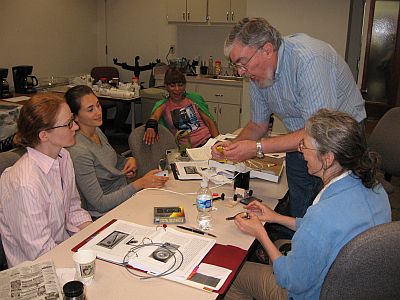 | 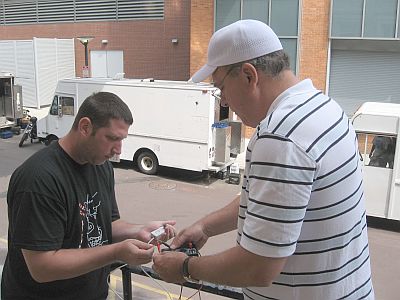 |
We are indebted to noted solar power researcher David Faiman, Director of the Ben-Gurion National Solar Energy Center and Chairman of the Department of Solar Energy & Environmental Physics at Ben-Gurion University's Jacob Blausteins for Desert Research in Sde Boker, for installing two IESRE pyranometers at a Negev desert site. One is horizontal to Earth's surface and the other is tilted 30° to the south in the same plane as a solar array.
This is an extremely harsh environment for any instrument, and especially for pyranometers that are continuously exposed to sunlight. How well would the $20 IESRE pyranometer hold up in this environment?
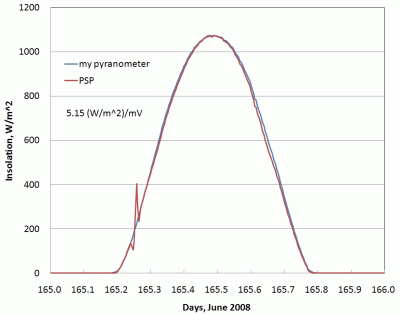 |
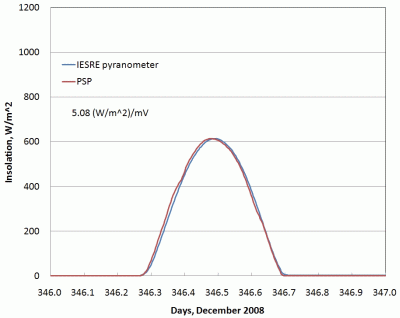 |
 |
|
The three figures show data for a single day in June 2008, December 2008, and June 2009. The comparison is between an IESRE pyranometer and an Eppley PSP thermopile pyranometer. The calibration constants used to convert the IESRE pyranometer voltages range from 5.05 to 5.15 (W/m2)/mV -- a range of 2%. This is remarkably stable performance for these kinds of instruments; even the very expensive PSP pyranometers experience calibration drift and need to be recalibrated frequently.
A research project in an alpine meadow in Colorado's San Juan Mountains included two-channel radiometers designed by IESRE. These inexpensive instruments allowed researchers to monitor 16 sites, where snow melt was artificially manipulated. The radiometers were used to monitor the status of snow cover at each site and track the growth of vegetation.
Proceedings of the National Academy of Sciences, "Early Edition," 02 July 2009
Biological consequences of earlier snowmelt from desert dust deposition in alpine landscapes
Heidi Steltzera,Chris Landryb, Thomas H. Painterc, Justin Andersona,
and Edward Ayresa
aNatural Resource Ecology Laboratory, Colorado State University, Fort Collins, CO 80523-1499
bCenter for Snow and Avalanche Studies, P.O. Box 190, Silverton, CO 81433-0190
cDepartment of Geography, University of Utah, Salt Lake City, UT 84112-9155
dMountain Studies Institute, P.O. Box 426, Silverton, CO 81433-0426
Abstract
Dust deposition to mountain snow cover, which has increased since the late 19th century,
accelerates the rate of snowmelt by increasing the solar radiation absorbed by the snowpack.
Snowmelt occurs earlier, but is decoupled from seasonal warming. Climate warming advances the
timing of snowmelt and early season phenological events (e.g., the onset of greening and flowering);
however, earlier snowmelt without warmer temperatures may have a different effect on phenology. Here,
we report the results of a set of snowmelt manipulations in which radiation-absorbing fabric and
the addition and removal of dust from the surface of the snowpack advanced or delayed snowmelt
in the alpine tundra. These changes in the timing of snowmelt were superimposed on a system where
the timing of snowmelt varies with topography and has been affected by increased dust loading.
At the community level, phenology exhibited a threshold response to the timing of snowmelt.
Greening and flowering were delayed before seasonal warming, after which there was a linear
relationship between the date of snowmelt and the timing of phenological events. Consequently,
the effects of earlier snowmelt on phenology differed in relation to topography, which resulted
in increasing synchronicity in phenology across the alpine landscape with increasingly earlier
snowmelt. The consequences of earlier snowmelt from increased dust deposition differ from climate
warming and include delayed phenology, leading to synchronized growth and flowering across the
landscape and the opportunity for altered species interactions, landscape-scale gene flow via
pollination, and nutrient cycling.
See also this report about Heidi Steltzer's work at www.sciencenews.org.
This photo shows long-time friend and colleague Forrest Mims calibrating one of IESRE's sun photometers at Mauna Loa Observatory in Hawaii. Two of these instruments, built almost 6 years ago as part of our work with the GLOBE Program, are used as references for calibrating sun photometers provided by IESRE. They have been calibrated by Forreset at MLO every year since 2004, and have shown remarkable stability over this time.
Sun photometers are calibrated using the "Langley plot method," which involves collecting data over a wide range of sun angles, usually from early morning to near noon. The catch is that sky conditions need to be very stable over the several hours required to collect the data. Such conditions are hardly ever found except at high-elevation sites such as MLO, so this observatory has become the "gold standard" location for these kinds of calibrations.
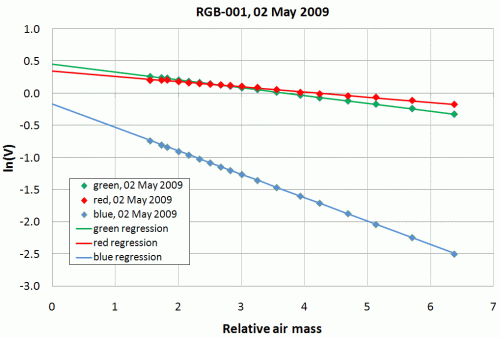 |
A mathematical analysis of how sun photometers work shows that, under constant sky conditions, the logarithm of the output
voltage of the instrument as a function of the relative air mass, based on the elevation of the sun above the horizon, must be a straight line. This straight
line is extrapolated back to a relative air mass of 0 and that value, which determines the output voltage from the instrument if there were no atmosphere between the instrument
and the sun, provides a calibration constant. Each instrument has a slightly different response, so every instrument must be calibrated individually. It is
impractical to do a Langley plot calibration for every instrument, so the alternative is to calibrate "field" instruments by comparing their output
to a reference instrument that has been calibrated using the Langley plot method. The graph shows some very high quality Langley plots based on data collected by Forrest on May 2nd. Collecting these data, usually for several different instruments at once, is very labor-intensive and requires intense concentration over several hours. Because of the nature of the Langley plot, which involves calculating logarithms and the sun's position in the sky, it is not possible as a practical matter for an observer to "fudge" the data (voltage and time) as they are being collected. As an additional check on data quality, our policy has always been for Forrest to send the raw data to me for constructing the Langley plots independently. So, when the plots are this linear, as predicted by theory for ideal atmospheric conditions, we have very high confidence in the resulting calibrations and, as a result, very high confidence in the atmospheric optical thickness data collected by these instruments. |
| Long-time data contributor Wade Geery, from Arrie Goforth Elementary School in Norfork, Arkansas, has sent this amazing picture of ice at his pyranometer site. Ice has covered the entire pyranometer assembly and the ice accumulation around the pyranometer cable is about 3 cm in diameter! Some homes in this area were without power for several weeks because of downed wires and utility poles. The righthand image shows the pyranometer with the ice gone. |  |
| On the third of three trips sponsored by the International Centre for Theoretical Physics, David Brooks led workshops at Thailand's Institute for the Promotion of Teaching of Science and Technology (IPST), Bangkok, and Maejo University, Chiang Mai. He also gave a lecture (translated into Thai) on student climate science research to approximately 700 undergraduates at Walailak University, Nakhon Si Thammarat, and visited a school on Koh Samui (Samui Island), off the east coast of Thailand. As a result of this project, 100 IESRE pyranometers will be distributed to schools in Thailand, along with an inexpensive data logger designed by Professor Sirichote Wichit \at King Mongkut's Institute of Technology, Ladkrabang. This new instrument will have many educational and research applications because it provides 20-bit analog-to-digital conversion resolution in a very inexpensive package, using SD memory cards (such as are used for digital cameras, for example) for data storage. | 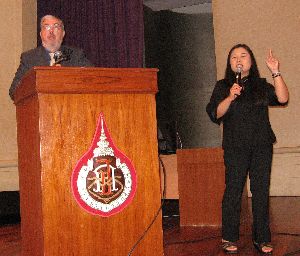 | 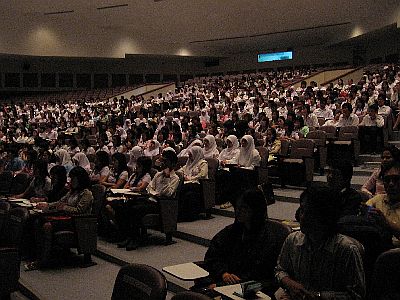 |
| The August 2008 entry, below, reported Dr. Robert Hellstrom's use of IESRE pyranometers on Easton Glacier. That equipment test was in preparation for collecting data in the extreme Antarctic environment, in collaboration with Dr. Andrew Klein, Texas A&M University. The photos here show two pyranometers used to measure incident and reflected broadband solar radiaion on the snow-covered sea ice near McMurdo Station. The pole on which the equipment is mounted is bamboo, as PVC pipe is not allowed at McMurdo Station! | 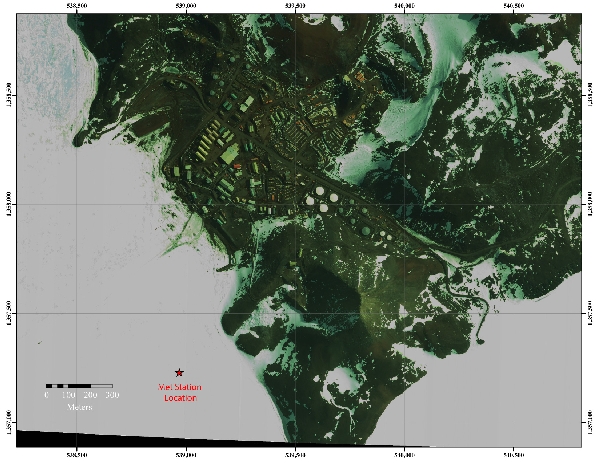 | 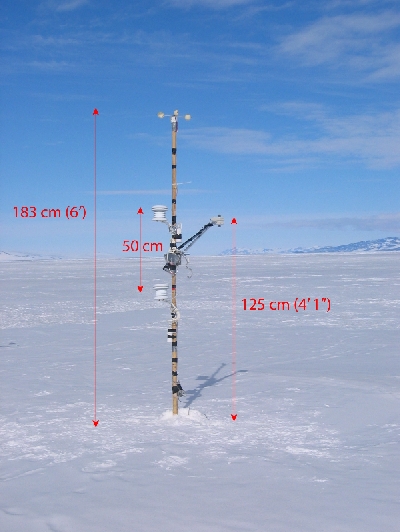 |
|
See here for a summary of Kristin Bondo's studies of tree
roosting bats in Canada. | 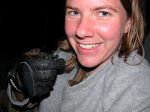 |
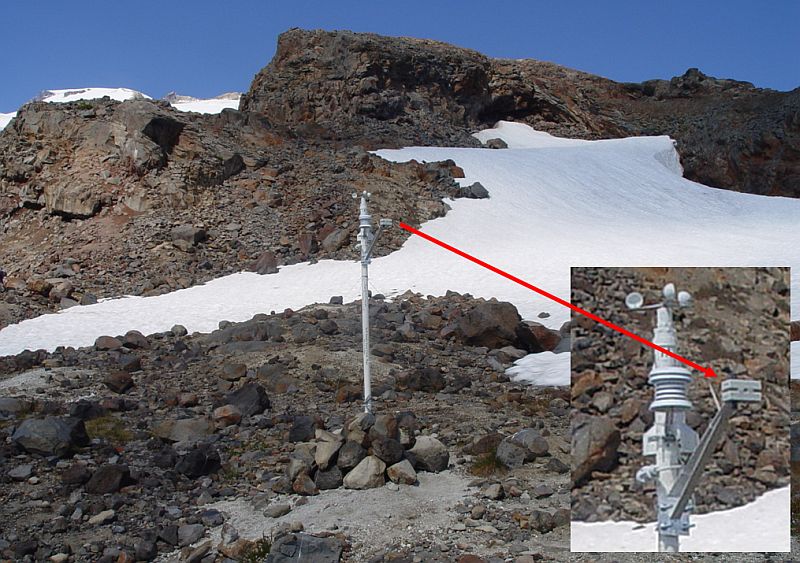 August 2008: IESRE pyranometers on Mt. Baker, Washington Cascades
August 2008: IESRE pyranometers on Mt. Baker, Washington CascadesGlacier researcher Dr. Robert Hellstrom, from Bridgewater State College, Bridgewater, MA, has sent this photo of two IESRE pyranometers mounted on a custom-built weather station (note the heavy-duty support structure) near the terminus of the Easton Glacier on Mt. Baker, in Washington's Cascade Mountains. He and his team have installed several of these stations around the glacier, each of which includes two pyranometers to measure insolation and surface reflectance. Additional measurements include wind speed, soil and air temperature, and relative humidity.
Hellstrom, along with a growing number of other researchers, has chosen these inexpensive pyranometers to spread restricted research instrumentation budgets over multiple data collection sites. This station is near a frequently used hiking trail, so the small and and unobtrusive IESRE instruments might also reduce the curiosity of passing hikers.
August 2008: Environmental Education Grant Award from Pennsylvania Department of Environmental Protection
The Institute for Earth Science Research and Education has received a $14,400 grant from Pennsylvania's Department of Environmental Protection for professional development workshops about solar energy. These grants are funded from fines collected by Pennsylvania as a result of environmental violations. PECO Energy, a major energy supplier in Pennsylvania, has agreed to provide an additional $3,000 for the project. IESRE will conduct this project in collaboration with the Schuylkill Center for Environmental Education and Green Woods Charter School, both in Philadelphia. SCEE will host the workshops and a science teacher from Green Woods will help the project develop strategies for assessing student work on these kinds of hands-on activities. Participants will learn about solar cells, build simple solar-powered car kits, and build pyranometers -- instruments for monitoring solar energy available at Earth's surface. All activities will be keyed to Pennsylvania's Environment and Ecology and Science and Technology education standards.
David Brooks presented a solar science and energy workshop for teachers in Drexel University's Math and Science Partnership. The workshop uses solar cells, inexpensive solar car kits and the pyranometers developed by Dr. Brooks to give teachers some hands-on experience with solar concepts. As always, the solar car kits were a big hit and cooperative weather made it possible to test everything outside under realistic conditions. Also included was a solar water heating experiment, using soft drink bottles. See here for photos.
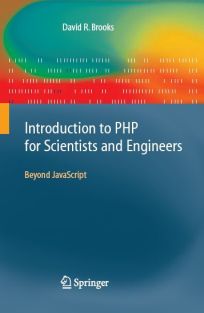 | 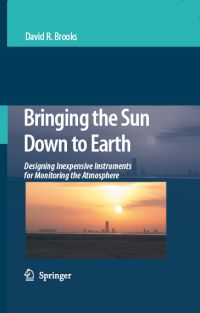 |
The first book:
David R. Brooks
Introduction to PHP for Scientists and Engineers
Springer, 2008
ISBN 978-1-84800-236-4
David R. Brooks
Bringing the Sun Down to Earth: Designing Inexpensive Instruments for Monitoring
the Atmosphere
Springer, 2008
ISBN 978-1-4020-8693-9
brings together several years of work on the development of inexpensive and reliable atmospheric monitoring instruments for use in research and education. It is a major expansion of Brooks' online document Monitoring Solar Radiation and Its Transmission Through the Atmosphere.
| Peruvian researchers from the "Machu Picchu" Peruvian Antartic Station during ANTAR XVIII campaign. From left to right: 1. Jose Castillo, with a Microtops from the Directorate of Aeronautic Meteorology 2. Ana Contreras, with a SP02-L from the University Alas Peruanas at Huancayo, Peru 3. Luis Suarez, with an IESRE sun photometer from the Research Institute for Technological Development - ININDETEC, Peru Note the cirrus clouds in the background. These can create serious problems for sun photometer measurements if they cover the sun. |  |
In November, David Brooks attended the Asia-Pacific GLOBE Learning Expedition in Hua Hin, Thailand, sponsored by the Institute for the Promotion of Teaching Science and Technology (IPST), which manages the GLOBE program in Thailand, and with travel support from the International Centre for Theoretical Physics. The workshop was attended by about 100 teachers and students from Thailand, Lao PDR, and Sri Lanka. Dr. Brooks gave a special invited presentation on student climate change research (click here for Word and PowerPoint versions), and conducted student/teacher workshops on building small solar-powered cars (click here for PowerPoint) and pyranometers -- instruments for measuring solar energy at Earth's surface. Click here for photos.
Brooks, David R., Forrest M. Mims III, Richard Roettger, Inexpensive Near-IR Sun Photometer for Measuring Total Column Water Vapor, Journal of Atmospheric and Oceanic Technology, 24, 1268-1276, 2007.
 July, 2007. David Brooks' new book, an Introduction to HTML and JavaScript for Scientists and Engineers, ISBN: 978-1-84628-656-8,
is now available.
For more information, see the
book's Springer web site.
July, 2007. David Brooks' new book, an Introduction to HTML and JavaScript for Scientists and Engineers, ISBN: 978-1-84628-656-8,
is now available.
For more information, see the
book's Springer web site.
